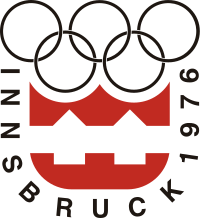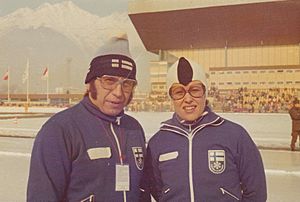1976 Winter Olympics facts for kids

Emblem of the 1976 Winter Olympics
|
|||
| Host city | Innsbruck, Austria | ||
|---|---|---|---|
| Nations | 37 | ||
| Athletes | 1,123 (892 men, 231 women) | ||
| Events | 37 in 6 sports (10 disciplines) | ||
| Opening | 4 February 1976 | ||
| Closing | 15 February 1976 | ||
| Opened by | |||
| Cauldron |
Christl Haas
Josef Feistmantl |
||
| Stadium | Bergisel | ||
| Winter | |||
|
|||
| Summer | |||
|
|||
The 1976 Winter Olympics, also known as the XII Olympic Winter Games or Innsbruck 1976, was a major winter sports event. It took place in Innsbruck, Austria, from February 4 to 15, 1976. This was the second time Innsbruck hosted the Winter Olympics, as it also did in 1964. Innsbruck became the host city after Denver, the city originally chosen, decided not to host the Games in 1972.
Contents
Choosing the Host City for the Games
Several cities wanted to host the 1976 Winter Olympics. These included Denver, USA; Sion, Switzerland; Tampere, Finland; and Vancouver, Canada. In 1970, the IOC chose Denver, Colorado, to host the Games.
However, in November 1972, the people of Colorado voted against spending money on the Olympics. This was the first time a city chosen to host the Winter Games decided to withdraw. Denver officially pulled out on November 15, 1972. The IOC then offered the Games to Whistler, British Columbia, Canada, but they also said no.
Finally, on February 5, 1973, the IOC chose Innsbruck to host the 1976 Winter Olympics. Innsbruck had already successfully hosted the Games just twelve years earlier in 1964.
Meet Schneemann: The Olympic Mascot
The official mascot for the 1976 Winter Olympics was a snowman named Schneemann. He wore a red Tyrolean hat. Walter Pötsch designed Schneemann to show that the 1976 Games would be "Games of Simplicity." Schneemann was also seen as a good-luck charm. He was meant to help avoid the lack of snow that had caused problems during the 1964 Winter Olympics in Innsbruck.
Exciting Moments and Highlights
- These were the first Olympic Games led by Michael Morris, 3rd Baron Killanin, the new president of the IOC.
- Austrian favorite Franz Klammer won the men's downhill ski event. He finished in 1 minute, 45.73 seconds, despite huge pressure from his home country and the defending champion.
- Dorothy Hamill from the United States won a gold medal in figure skating. Her popular "wedge" haircut became a trend.
- British figure skater John Curry changed his routine to impress the Olympic judges. His elegant performance earned him a gold medal.
- American figure skater Terry Kubicka successfully performed a difficult backflip during his routine.
- Rosi Mittermaier from West Germany almost won all the women's alpine skiing events. She won two gold medals and one silver, missing a third gold by only 0.13 seconds.
- Soviet speed skater Tatiana Averina had a fantastic performance, winning four medals.
- In the 4-man bobsled event, the team from East Germany won their first of three gold medals in a row.
- The USSR ice hockey team won their fourth straight Olympic gold medal. Canada did not send a team for the second Olympics in a row. They were protesting rules that allowed the USSR to use professional players while Canada could only use amateurs. Sweden also joined this boycott.
- New sports technology appeared at these Games. Innovative skis with holes, sleek hooded suits, and streamlined helmets were used in alpine skiing, speed skating, and ski jumping.
- A second cauldron for the Olympic flame was built to mark the 1976 Games. Both the 1964 and 1976 cauldrons were lit together.
- Bobsleigh and luge events took place on the same track for the very first time.
- Galina Kulakova from the Soviet Union finished third in the women's 5 km ski event. However, she was disqualified because she tested positive for a banned substance called ephedrine. She said it was from a nasal spray she used. Both the FIS and the IOC still allowed her to compete in other races. This was the first time a medal was taken away at the Winter Olympics.
- The Austrian anthem was played three times at the closing ceremony. This honored the three verses of the anthem.
Olympic Event Locations
- Axamer Lizum – Most alpine skiing events
- Bergiselschanze – Ski jumping (large hill), Opening Ceremonies
- Eisschnellaufbahn – Speed skating
- Kombinierte Kunsteisbahn für Bob-Rodel Igls – Bobsleigh, Luge
- Messehalle – Ice hockey
- Olympiahalle – Figure skating, Ice hockey, Closing Ceremonies
- Patscherkofel – Men's downhill alpine skiing
- Seefeld – Biathlon, Cross-country skiing, Nordic combined, Ski jumping (normal hill)
Sports and Medals Awarded
There were 37 events in 6 sports, which included 10 different types of competitions. Ice dance was a new event at these Olympics. Here are the sports where medals were given out:
- Alpine skiing (6)
- Biathlon (2)
- Bobsleigh (2)
- Cross-country skiing (7)
- Figure skating (4)
- Ice hockey (1)
- Luge (3)
- Nordic combined (1)
- Ski jumping (2)
- Speed skating (9)
Countries Taking Part
A total of 37 nations sent athletes to the 1976 Winter Olympic Games. This was the last time Taiwan (officially the Republic of China) competed using its original flag and name. After many countries recognized the People's Republic of China, Taiwan had to compete as Chinese Taipei with a different flag and anthem in future Games. Andorra and San Marino competed in the Winter Olympics for the very first time.
Medal Count by Nation
Here are the top ten countries that won the most medals at the 1976 Winter Games:
* Host nation (Austria)
| Rank | Nation | Gold | Silver | Bronze | Total |
|---|---|---|---|---|---|
| 1 | 13 | 6 | 8 | 27 | |
| 2 | 7 | 5 | 7 | 19 | |
| 3 | 3 | 3 | 4 | 10 | |
| 4 | 3 | 3 | 1 | 7 | |
| 5 | 2 | 5 | 3 | 10 | |
| 6 | 2 | 4 | 1 | 7 | |
| 7 | 2 | 2 | 2 | 6 | |
| 8 | 1 | 3 | 1 | 5 | |
| 9 | 1 | 2 | 3 | 6 | |
| 10 | 1 | 2 | 1 | 4 | |
| Totals (10 entries) | 35 | 35 | 31 | 101 | |
More to Explore
 In Spanish: Juegos Olímpicos de Innsbruck 1976 para niños
In Spanish: Juegos Olímpicos de Innsbruck 1976 para niños
- 1976 Winter Paralympics
- 1976 Summer Paralympics
- 1976 Summer Olympics
- Olympic Games celebrated in Austria
- 1964 Winter Olympics – Innsbruck
- 1976 Winter Olympics – Innsbruck
- 2012 Winter Youth Olympics – Innsbruck




